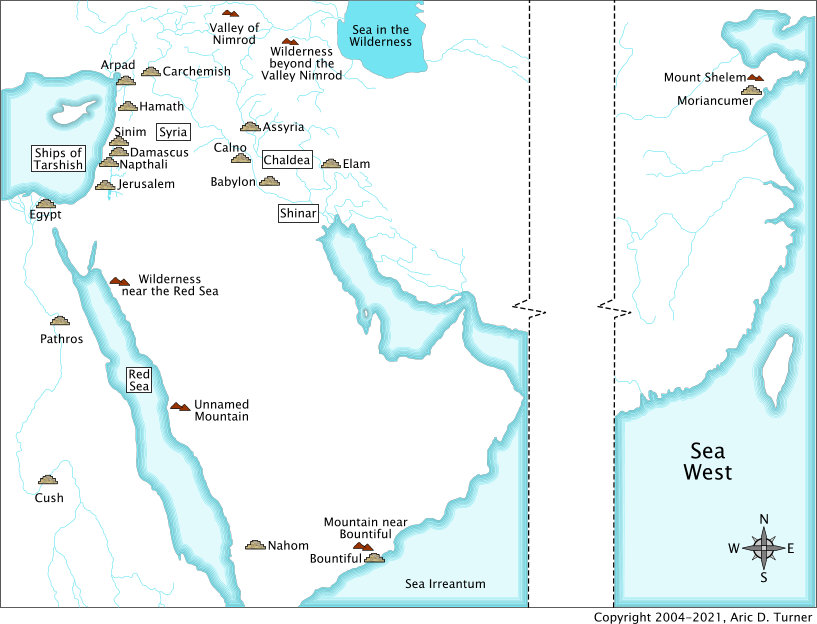Assyria bordered Egypt. It is mentioned in conjunction with Cush, Damascus, Egypt, Elam, Ephraim, Hamath, islands of the sea, Israel, Jerusalem, mount Zion, Pathros, Samaria, Shinar, and Syria. There is insufficient information in the Book of Mormon to place Assyria in relation to any of these places. Researchers have determined that the Assyrian Empire changed in size over time from an area north of Jerusalem to an area that extended as far south as Egypt and as far east as the Persian Gulf.
Commentaries (
view it on a map)
II NEPHI 9:31 [17:18]: And it shall come to pass in that day, that the Lord shall hiss for the fly that is in the uttermost part of Egypt, and for the bee that is in the land of Assyria.
Commentary: This verse references the places of Assyria and Egypt. This verse indicates that Assyria and Egypt are two different lands.
II NEPHI 9:42 [18:4]: For behold, the child shall not have knowledge to cry, My father, and my mother, before the riches of Damascus and the spoil of Samaria shall be taken away before the king of Assyria.
Commentary: This verse references the places of Assyria, Damascus, Ephraim, Samaria, and Syria. This verse also occurs in Isaiah 8:4. There is no information provided regarding their locations except the phrase 'taken away' indicates Damascus (Syria) and Samaria (Ephraim) are probably located outside of Assyria.
II NEPHI 9:93 [20:12]: Wherefore it shall come to pass, that when the Lord hath performed his whole work upon mount Zion and upon Jerusalem, I will punish the fruit of the stout heart of the king of Assyria, and the glory of his high looks.
Commentary: This verse references the places of Assyria, Jerusalem, and mount Zion. This verse also occurs in Isaiah 10:12. These places are named but no information is provided regarding their locations. Biblical scholars place mount Zion as the hill next to, and westward, of Jerusalem.
II NEPHI 9:126 [21:11]: And it shall come to pass in that day, that the Lord shall set his hand again the second time to recover the remnant of his people, which shall be left from Assyria, and from Egypt, and from Pathros, and from Cush, and from Elam, and from Shinar, and from Hamath, and from the islands of the sea.
Commentary: This verse references the places of Assyria, Cush, Egypt, Elam, Hamath, the islands of the sea, Pathros, and Shinar. This verse also occurs in Isaiah 11:11. These are listed in the same verse so they join borders (or do not have any lands in between them). There is insufficient information in the Book of Mormon to locate these places. However, their locations are known. As listed, and in the 7th century BCE, they did share borders or did not have any lands in between them. The Assyrian Empire (captial city was Ninaveh) stretched to Egypt. The capital city was known as Zoan to the Hebrews or as Tannis to the Egyptians. Egypt covered the lower Nile. Pathros (capital city was Thebes) bordered Egypt and covered the middle Nile. Cush (capital city was Napata) bordered Pathros and covered the upper Nile. The area between Cush and Elam was the Arabian Peninsula and there was no organized ruler or empire claiming that area. Elam (captial city was Susa) bordered Shinar (captial city of Babylon). Hamath (captial city was Hamath) bordered Shinar. The phrase 'islands of the sea' indicates all other lands outside of these countries that surrounded Israel.
II NEPHI 9:131 [21:16]: And there shall be a highway for the remnant of his people, which shall be left, from Assyria, like as it was to Israel in the day that he came up out of the land of Egypt.
Commentary: This verse references the places of Assyria, Egypt, and Israel. This verse also occurs in Isaiah 11:16. The term 'his' refers to the Lord. This verse identifies Assyria, Egypt and Israel are separate places. The phrase 'came up out of' indicates that Israel is higher in altitude than Egypt and that Israel is located outside of Egypt.
Map











